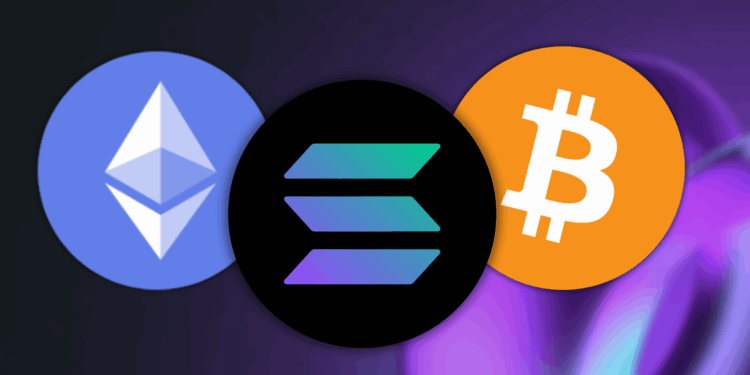- Solana has re-emerged as a top-performing Layer-1 blockchain in 2025, driven by fast transactions, low fees, and a vibrant DeFi and NFT ecosystem.
- Its unique architecture—featuring Proof of History, Sealevel parallel execution, and ultra-low latency—solves major blockchain bottlenecks and enables real-time, high-frequency applications.
- With upcoming upgrades like Firedancer and growing adoption across payments, gaming, and mobile, Solana is positioning itself as a foundational layer for the next wave of Web3 growth.
In the ongoing battle of Layer-1 blockchains, one network has managed to claw its way back to the top and claim the spotlight in this bull market – Solana. The once-embattled chain that suffered downtime, centralization criticism, and the fallout from FTX’s collapse has not only survived but thrived. With blistering transaction speeds, negligible fees, and a rapidly expanding ecosystem spanning DeFi, NFTs, gaming, and payments, Solana has become one of the most talked-about platforms in crypto.
Notably, in a market where attention is currency and performance is everything, Solana is delivering both. Now among the top blockchains by market cap, daily active users, and transaction volumes, this network is doing what many dismissed as impossible during the ups and downs of this market. So, let us take a closer look at what makes Solana tick, how it works, what problems it is solving, and why this high-performance chain has once again captured the market’s imagination.
What Is Solana?
Solana is a high-speed, high-throughput Layer-1 blockchain built for scalability and real-world usability. Launched in 2020 by Solana Labs and now maintained by the Solana Foundation in Geneva, the network is engineered to handle tens of thousands of transactions per second at a fraction of a cent in cost. It was designed from the ground up to be fast, developer-friendly, and efficient — a counter to the slow, expensive transactions that plagued early blockchains like Ethereum.
However, what makes Solana unique is not just speed for speed’s sake. It is about enabling entire sectors of dApps that simply are not feasible on slower, higher-fee networks. From micropayments and high-frequency trading to NFT minting and mobile-first Web3 applications, Solana was built to handle use cases where cost and confirmation times are critical.
By blending proof-of-stake with its own innovation — proof-of-history — Solana achieves an unrivaled combination of performance, security, and accessibility. Essentially, the project aims to become the infrastructure layer for scalable, censorship-resistant applications across finance, media, social, and beyond.
How Does It Work?
Solana’s architecture is a cocktail of custom-built components that power its distinct speed advantage. Each piece is engineered to remove traditional bottlenecks in blockchain systems, working together to deliver high throughput and low latency without sacrificing decentralization. This includes:
Proof of History (PoH)
At the heart of Solana’s design is Proof of History, a cryptographic timestamping mechanism that orders transactions before they enter the consensus process. This acts as a verifiable clock for the network, dramatically reducing the coordination overhead between validators. Overall, by pre-ordering transactions, PoH eliminates the need for nodes to agree on time, accelerating block production.
Proof of Stake (PoS)
Solana uses a PoS framework where validators stake SOL tokens to participate in block validation and consensus. The more SOL a validator stakes, the higher their chance of being selected to produce the next block. Misbehavior results in penalties or loss of stake, incentivizing honest network participation while minimizing the energy demands seen in proof-of-work systems.
Tower BFT
Tower BFT is Solana’s customized Byzantine Fault Tolerance system, optimized to work hand-in-hand with Proof of History. It allows validators to make fast, pre-committed votes on the validity of proposed blocks based on historical proof timestamps. This lightweight consensus mechanism helps finalize blocks in under a second while protecting the network against malicious actors and node failures.
Sealevel
Most blockchains process smart contracts sequentially, one after another, creating significant bottlenecks during high activity. Sealevel solves this by enabling parallel smart contract execution. It identifies transactions that do not conflict and runs them simultaneously across multiple CPU cores, allowing thousands of programs to execute without slowing the entire network.
Gulf Stream
Gulf Stream overhauls the way transactions are forwarded across the network. Instead of sitting in a mempool waiting to be picked up by validators, transactions are proactively routed to the validators most likely to confirm the next block. This reduces latency, prevents network congestion, and improves transaction confirmation speeds during peak demand.
Turbine
Data propagation is a challenge in distributed systems, especially with thousands of validators. Turbine addresses this by breaking data into smaller, manageable packets and distributing them using a gossip-like protocol. Each validator sends chunks to a targeted subset of peers, dramatically speeding up block transmission across the network while minimizing bandwidth usage.
Cloudbreak and Archivers
Solana uses two systems to manage data efficiently as the network grows. Cloudbreak organizes and processes all the active account data, handling many reads and writes at once to keep transactions smooth. Meanwhile, Archivers are separate nodes that store older transaction history off the main network, ensuring Solana stays fast and does not get bogged down by huge amounts of stored data.
What Problems Does It Solve?
Solana entered the scene to tackle the blockchain trilemma—balancing decentralization, scalability, and security. Most older networks like Bitcoin and Ethereum hit hard ceilings in at least one of these categories. However, Solana reduces these constraints by:
- Scaling natively on Layer 1, without the need for external protocols
- Delivering reliable transaction throughput for real-time applications like gaming, trading, and streaming
- Supporting frictionless microtransactions, due to its negligible fees
- Providing developers with optimized tools to deploy smart contracts with confidence
By doing so, it is enabling categories of blockchain usage that were previously unattainable—low-latency DeFi trading, mobile-native Web3 apps, high-frequency NFT minting, and permissionless stablecoin payments for retail.
Utility and Offerings
Solana’s value proposition extends far beyond speed and fees. Its growing utility is anchored by its native token, SOL, and a suite of applications spanning multiple sectors.
SOL Token
SOL is the fuel of the Solana network. It is used for staking, transaction fees, governance voting, and as collateral in DeFi applications.
Staking and Network Security
Validators secure the network by staking SOL, earning rewards for their service. Delegators can also stake their SOL with validators, sharing in the rewards while contributing to the network’s decentralization.
DeFi Ecosystem
Solana hosts a fast-growing DeFi scene, including DEXs like Jupiter and Raydium, lending platforms such as Solend and MarginFi, and trading protocols that rival Ethereum’s largest platforms. Solana’s high-speed settlement and low fees make it an ideal environment for DeFi, with daily DEX volumes frequently surpassing Ethereum.
NFTs and Marketplaces
Solana’s NFT scene exploded in 2021 and continues to thrive, driven by fast, cheap minting and active marketplaces like Magic Eden.
Gaming and Web3 Applications
With ultra-fast transaction speeds, Solana is uniquely suited for blockchain gaming. Projects like Star Atlas, Aurory, and STEPN have built active communities, while Solana’s push into mobile with the Solana Saga smartphone aims to bring Web3 to mainstream audiences.
Payments and Stablecoins
Solana Pay, Visa integrations, and growing stablecoin adoption position Solana as a serious player in crypto-based payments. Its negligible fees and instant settlement make it an obvious choice for merchants and users alike.
DePIN and AI Integration
Solana is also carving a niche in decentralized physical infrastructure (DePIN) and AI applications. Its low-latency, high-throughput design makes it suitable for systems that demand fast, efficient transaction processing on a global scale.
Ecosystem and Adoption
Solana’s ecosystem growth has been relentless. Despite the setbacks of 2022–2023, including network outages and FTX’s implosion, the network bounced back with new upgrades, validator clients, and a surge in developer activity.
Today, Solana boasts over 1000 active validators and thousands of dApps. In Q1 2025 alone, Solana-based apps generated more than $1.2 billion in revenue, driven by trading, DeFi, and memecoin speculation. Solana even managed to surpass Ethereum in daily DEX trading volume, a milestone few thought possible during its downtime-plagued period.
Beyond trading and DeFi, Solana’s NFT market remains active, and its gaming vertical continues to expand. In addition to this, the release of the Solana Saga phone marks a bold attempt to capture the mobile-first Web3 audience, integrating native crypto features directly into hardware.
On the enterprise front, Solana’s efficient and scalable infrastructure is gaining traction among major players. Visa and Shopify have integrated Solana’s blockchain solutions into their payment systems, showcasing growing confidence from the traditional financial and e-commerce sectors. Additionally, the network’s architecture is attracting projects in AI and decentralized physical infrastructure (DePIN), highlighting its potential to power the next generation of technology applications.
Roadmap and Plans Ahead
Solana’s roadmap is ambitious—and it has the technical chops to back it up. The headline upgrade is Firedancer, a new validator client by Jump Crypto, built to supercharge throughput, slash latency, and harden network resilience. It is in testing now, with mainnet launch targeted for late 2025.
Alongside that, upgrades like Alpenglow and improvements to QUIC networking aim to fine-tune consensus speed and congestion management. The Solana Foundation is doubling down on ecosystem expansion too, with ongoing developer grants, DePIN infrastructure pushes, and AI-integrated protocol initiatives.
On the other hand, speculation around a Solana spot ETF is heating up. After Ethereum ETFs cleared regulatory hurdles, Solana has emerged as a frontrunner for the next approval wave. Such a move would inject major institutional capital and legitimize Solana as a top-tier crypto asset alongside BTC and ETH.
Overall, the focus now is refining reliability, further decentralizing validators, and scaling to meet rising demand. If it delivers, Solana will be one of the most strategically important L1 blockchain in Web3.
Final Thoughts
In conclusion, Solana has pulled off what most assumed was out of reach — it turned a narrative of outages, centralization critiques, and high-profile collapses into a story of resilience, performance, and undeniable market relevance. Looking ahead, with Solana staking entering ETF territory, stablecoin velocity accelerating, memecoins gaining massive attention on the network, and mobile-native dApps finding real traction, Solana looks less like a fleeting hype cycle and more like a serious contender to anchor the next generation of consumer-grade blockchain infrastructure.














